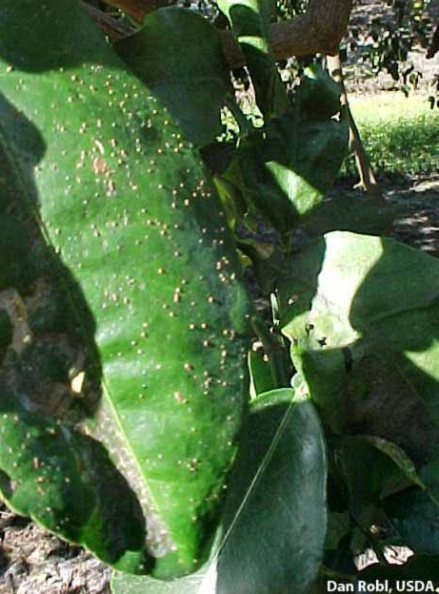 Melanose
Melanose
Scientific Name
[Fungus] Diaporthe citri F.A. Wolf (syn. D. medusaea Nitschke)
Anamorph Phomopsis citri H. Fawc Non (Sacc.) Traverso and Spessa
Other common names
Star melanose, mudcake melanose
 Disease cycle
Disease cycle
Melanose is a saprophyte that completes its lifecycle on dead twigs. The disease severity is determined by the amount of inoculum on dead wood in the tree canopy and the duration of wetting periods following rainfall or overhead sprinkler irrigation. Around 18-24 hours of wetting are required for infection to occur and severe infection is favored by long periods of continuous wetting. Spores cause problems when there are significant amounts of dead wood on trees, on the ground or in piles of brush left in the grove.
Symptoms
Leaf - about one week after infection foliar symptoms appear as small brown discrete spots. These spots become impregnated with a reddish-brown gum and are raised above the leaf surface. Early pustules on leaves are surrounded by a yellow halo. However, this halo quickly disappears leaving only small corky pustules. The numerous small pustules give the leaf a rough sandpaper texture. Distortion and dieback of young shoots are associated with severe infections.
Fruit - fruit symptoms can vary depending on the age of the fruit at the time of infection. Early infections, soon petal fall, will show relatively large pustules and when in large numbers they may coalesce to form extensive areas that often crack to produce a pattern described as "mudcake melanose". Infections during later stages of fruit development produces small discrete pustules distributed by spore-laden rain or dew which flows over the fruit surface creating the "tear-stain melanose" pattern. These injuries to the fruit rind are superficial and are not important if the crop is processed. If copper fungicides are applied for control, stippling, copper fungicide damage, may occur, which can resemble the disease and is often called star melanose.
Host range
All citrus cultivars.
Distribution
Present in most citrus producing counties.
We currently serve - Mesa – Gilbert - Tempe - Chandler - Queen Creek - Scottsdale – Paradise Valley - East Phoenix Arizona.
